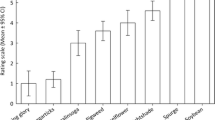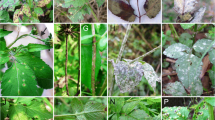Abstract
The non «B» biotype ofBemisia tabaci (Gennadius) is recorded for the first time in Crete in 1992, in the north east and south east of the island.Trialeurodes vaporariorum (Westwood) is the predominant whitefly on plants in the north and west of the island. Three surveys of Crete were made in 1992 and 1993 for natural enemies ofB. tabaci andT. vaporariorum and resulted in the collection of 4 species ofEncarsia, (plus a number of species that are unidentifiable at this time), anEretmocerus sp. (unidentifiable at this time) and a fungal pathogen,Paecilomyces farinosus (Dickson Ex Fries) Brown & Smith.Encarsia adrianae was identified fromT. vaporariorum; which constitutes its most westerly distribution point and a new host record respectively.B. tabaci andT. vaporariorum were found on horticultural crops, ornamentals and weeds. Populations of both whitefly species were severely depleted on field hosts throughout the island during the winter of 1992/93. Climatic constraints, competition withT. vaporariorum in otherwise suitable niches, effective natural enemies and an observed low level of polyphagy may explain the present limited distribution of the non «B» biotype ofB. tabaci in Crete.
Résumé
Bemisia tabaci (Gennadius) a été signalé pour la première fois en Crète en 1992. L'aleurode est confiné au sud-est de l'île.Trialeurodes vaporariorum (Westwood) est l'aleurode prédominant au nord et à l'ouest de l'île. Trois prospections pour les ennemis naturels deB. tabaci ont été faites en Crète en 1992 et 1993. Ces prospections ont eu pour résultat la collecte de 4 espèces d'Encarsia, unEretmocerus sp. et un champignon pathogène,Paecilomyces farinosus (Holm Ex X. F. Gray) Brown & Smith.B. tabaci etT. vaporariorum ont été trouvés sur les cultures maraîchères, plantes ornementales et mauvaises herbes. Partout dans l'île, les populations des deux espèces ont été sévèrement réduites sur les plantes hôtes à l'extérieur pendant l'hiver 1992/93. Les contraintes climatiques, la concurrence avecT. vaporariorum pour les niches, et des ennemis naturels efficaces, peuvent expliquer la dispersion limitée deB. tabaci en Crète.
Similar content being viewed by others
References
Azim, M. N. &Shafee, S. A. — 1980. Indian species of the genusTrichaporus Foerster (Hymenoptera: Aphelinidae).J. Bombay Nat. Hist. Soc., 76, 335–338.
Cock, M. J. W. — 1986.Bemisia tabaci — a literature survey on the cotton whitefly with an annotated bibliography.IIBC, Silwood Park, UK, 121 p.
Costa, H. S. & Brown, J. K. — 1991. Biological characteristics and esterase patterns forBemisia tabaci populations, and the association of silverleaf symptom development in squash with one population.Ariz. Agr. Expt. Sta., 79–86.
Gerling, D., Motro, U. &Horowitz, R. — 1980. Dynamics ofBemisia tabaci (Gennadius) (Homoptera: Aleyrodidae) attacking cotton in the coastal plain of Israel.Bull. Entomol. Res., 70, 213–219.
Hayat, M. — 1986. Family Aphelinidae, pp. 143–171. InSubba Rao, B. R. & Hayat, M. (eds). The Chalcidoidea of India and the adjacent countries. Part 2. A catalogue of Chalcidoidea of India and the adjacent countries.Oriental Insects, 20, 1–430.
Hayat, M. — 1989. A revision of the species ofEncarsia Foerster (Hymenoptera; Aphelinidae) from India and the adjacent countries.Oriental Insects, 23, 1–131.
Hafez, M., Tawfik, M. F. S., Awadallah, K. T. &Sarhan, A. A. — 1983. Natural enemies of the cotton whitefly,Bemisia tabaci (Genn.), in the world and in Egypt.Bull. Soc. Entomol. Egypte, 62, 9–13.
Martin, J. H. — 1987. An identification guide to common whitefly pest species of the world (Homoptera, Aleyrodidae).Trop. Pest man., 33, 298–322.
Mound, L. A. &Halsey, S. H. — 1978. Whitefly of the world. A systematic catalogue of the Aleyrodidae (Homoptera) with host plant and natural enemy data. London; British Museum (Natural History), London,John Wiley & Sons. 340 p.
Osborne, L. S., Storey, G. K., McCoy, C. W. & Walter, J. F. — 1990. Potential for controlling the sweetpotato whitefly,Bemisia tabaci, with the fungus,Paecilomyces fumosoroseus. Proc. V. Int. Colloq. Invertebr. Pathol., 386–390.
Polaszek, A., Evans, G. A. &Bennett, F. D. — 1992.Encarsia parasitoids ofBemisia tabaci (Hymenoptera: Aphelinidae, Homoptera: Aleyrodidae): a preliminary guide to identification.Bull. Entomol. Res., 82, 375–392.
Rivnay, T. &Gerling D. — 1987. Aphelinidae parasitoids (Hymenoptera: Chalcidoidea) of whiteflies (Hemiptera: Aleyrodidae) in Israel, with description of three new species.Entomophaga, 32, 463–475.
Roditakis, N. E. — 1990. Host plants of greenhouse whiteflyTrialeurodes vaporariorum Westwood (Homoptera: Aleyrodidae) in Crete. Attractiveness and impact on whitefly life stages.Agric. Eco. Env., 31, 217–224.
Segonca, C. — 1982. The principal cotton pests and their economic thresholds in the Kilikien Plain in southern Turkey.Entomophaga 27, 51–56.
Viggiani, G. &Battaglia, D. — 1983. Le specie italiane del genereEretmocerus Hald (Hymenoptera: Aphelinidae).Boll. Lab. Entomol. Agr. ‘Filippo Silvestri’, 40, 97–101.
Author information
Authors and Affiliations
Rights and permissions
About this article
Cite this article
Kirk, A.A., Lacey, L.A., Roditakis, N. et al. The status ofBemisia tabaci (Hom.: Aleyrodidae),Trialeurodes vaporariorum (Hom.: Aleyrodidae) and their natural enemies in Crete. Entomophaga 38, 405–410 (1993). https://doi.org/10.1007/BF02374458
Received:
Accepted:
Issue Date:
DOI: https://doi.org/10.1007/BF02374458




